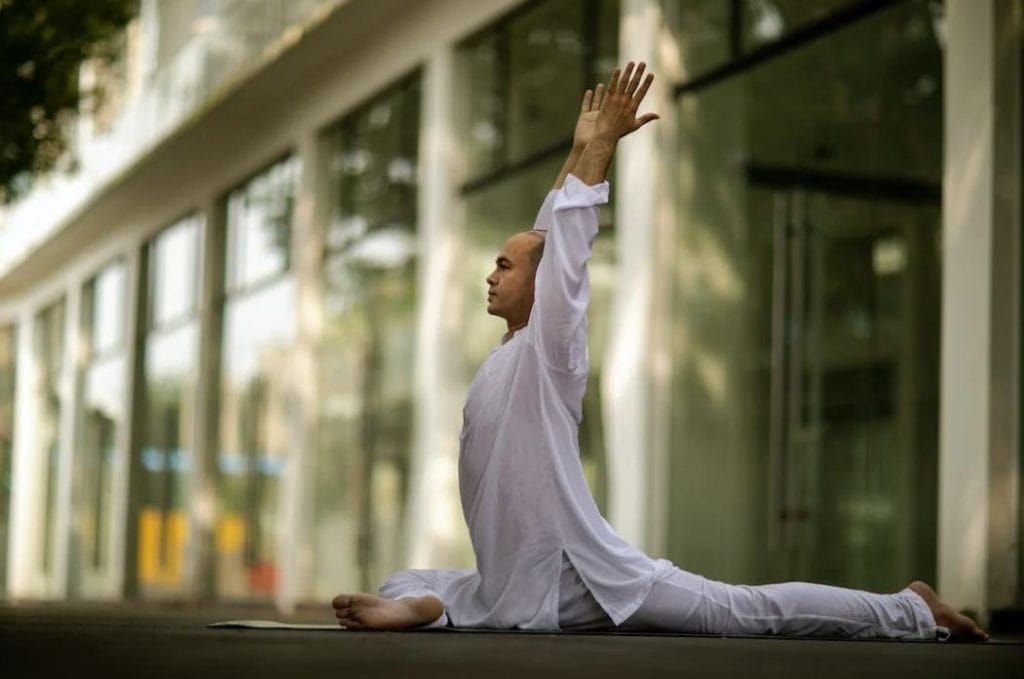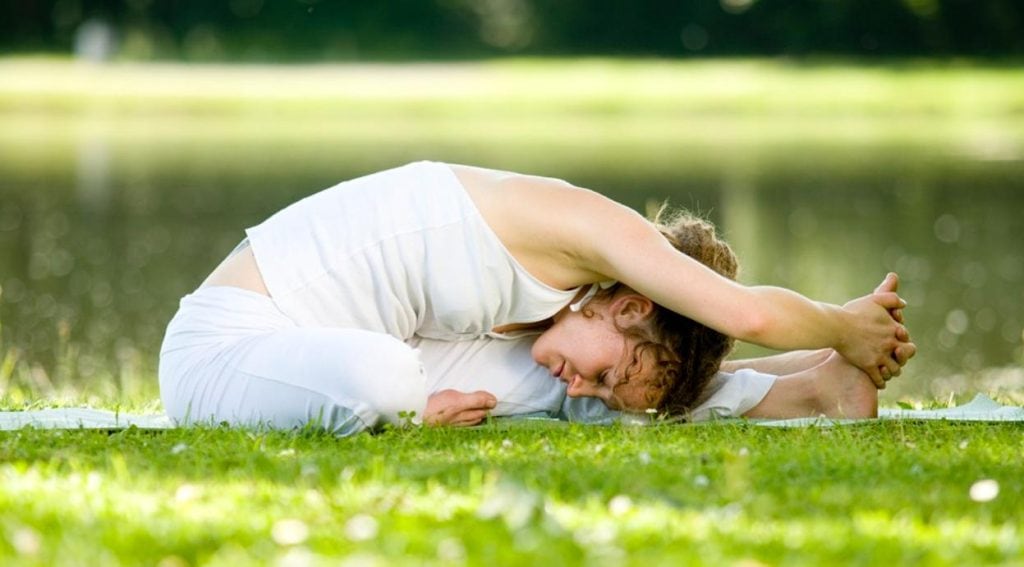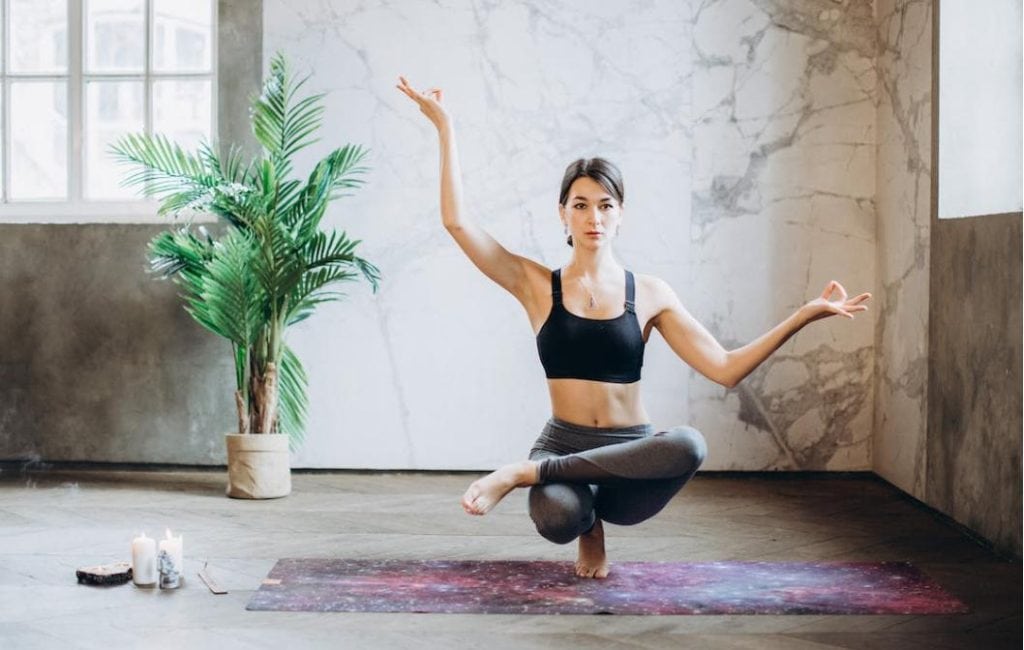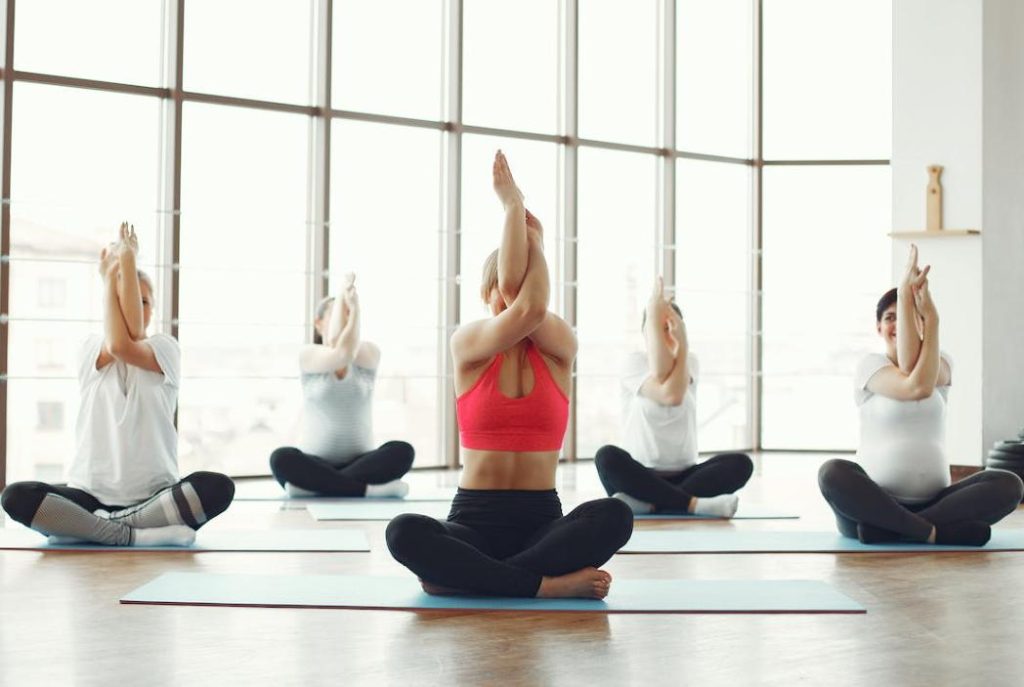Whether you’re looking to treat a specific health condition or improve your overall wellness, yoga is an excellent mind-body practice to adopt. The technique offers many physical and psychological benefits, and just about anyone can do it regardless of age and fitness level.
However, yoga goes beyond donning your favorite activewear, grabbing a mat, and doing a few poses. In fact, many people confuse the practice with similar low-impact exercises like Pilates. And this begs the question: what is yoga, really?
As you may have figured, you’re less likely to get any real benefits from yoga if you don’t understand the practice and how to do it correctly.
That’s why we’ve pieced this article together; it will help you grasp what yoga is, how it works, and the benefits that come with regular practice.
We’ll briefly cover a few different yoga types or styles to help you choose one that best suits your fitness level.
What Is Yoga?
Yoga is an ancient technique that uses controlled movements and contemplative practices to align the mind and body. It involves turning inward and being present to enhance the mind-body connection.
Essentially, yoga uses physical postures or poses (known as asanas in Sanskrit) with meditation and breathing (known as pranayama) to keep the practitioner grounded.
Yoga is a popular practice, with over 34 million Americans and more than 300 million people worldwide actively engaged in it. But this huge popularity is mostly because many focus on the physical movements or postures of the practice, using them as gentle forms of exercises for increasing flexibility or managing stress.
Many people mistake Pilates for yoga. And while both are similar, the former focuses on improving physical fitness while the latter offers physical, psychological, and spiritual benefits.
To be clear, yoga is not merely a form of exercise for improving muscular endurance and movement control. Indeed, increased flexibility and improved postural alignment are some benefits of doing yoga regularly.
But the main focus of the practice is on connecting the mind and body through the flow of movement.
Think of yoga as meditative movement.
It is a delicate combination of breathing techniques (pranayama) and physical poses (asanas) with mindfulness practices like meditation or chanting mantras.
The practice is believed to have originated in ancient India. Traditionally, yoga is a system that helps people cultivate self-regulation, awareness, and discernment.
Over the years, the practice has found its way to nearly all parts of the world, with modern yoga focused on promoting flexibility, calmness, and overall well-being on physical, emotional, mental, and spiritual levels.
If you’re new to yoga, you may be reluctant to practice it because of its somewhat religious connotations. Although the practice is historically linked to Buddhism, Hinduism, and Jainism, people of all faiths and traditions practice yoga, including atheists and agnostics.
For those who are skeptical, here’s what we recommend:
If something doesn’t resonate with you, ignore it! Simply focus on techniques that bring about yoga’s physical and psychological benefits.
How Does Yoga Work?

A research article published in the Journal of Yoga and Physical Therapy shows how yoga positively affects the body, keeping it healthy.
Without getting all science-y, the simple act of combining regulated breathing with controlled movement improves hormone regulation, particularly the stress hormone (cortisol).
In other words, regularly practicing yoga can decrease your cortisol levels, which reduces anxiety and stress. In turn, your ability to manage pain goes up, and your sense of well-being increases.
Additionally, regularly engaging in calming techniques with controlled physical movements activates the parasympathetic nervous system (PSNS). Your overall health is improved when your PSNS is activated because it:
- Lowers blood pressure
- Promotes digestion
- Slows your heart rate
- Slows down your breathing
In a nutshell, your body is relaxed when in the PSNS state, which helps recovery.
Another way yoga keeps the body in good physical health is by improving heart health. Regular asana and pranayama lowers blood pressure and prevent cardiovascular disease by slowing down the hardening of blood vessels.
All of this improves how your arteries work in distributing blood throughout the body. By boosting blood flow, regular yoga practice benefits the circulatory system.
Lastly, yoga interventions particularly designed to improve balance and increase physical strength have been shown to improve overall physical health.
Besides reducing the risk of diabetes, obesity, and heart disease, elderly people who practice regular yoga are less likely to have fall-related injuries. And women with endometriosis can use specific asanas to get quick relief from the excruciating pain of the disorder.
8 Benefits of Regular Yoga Practice

If you’re asking, “What is yoga?” it’s logical to also want to know what’s in it for you. The benefits of regular yoga practice are many and well-documented, and here are eight of them.
1. Increases Your Peace of Mind
By focusing on breath work and quieting your mind, yoga helps slow down stress-inducing desires as well as fearful, angry, regretful, and frustrating thought patterns.
Certain asanas like corpse pose, camel pose, and child’s pose are known to have a calming effect on the mind, enabling you to control the mind’s fluctuations and achieve inner peace.
2. Boosts Immune System
Your immune system is likely compromised if you fall ill too frequently. Thankfully, consistent yoga practice over a long time can boost immune system functionality. This is especially true if you focus on the meditative aspect of yoga.
3. Helps You Sleep Better
Restorative yoga practices, like yoga nidra, are great for providing the much-needed downtown for the nervous system, particularly in a stress-prone modern world.
This means yoga can help you have a restful sleep if you do it consistently. Besides better sleep, you will be less tired or exhausted if you combine asanas with the right pranayama techniques.
4. Increases Your Ability to Focus
During a typical yoga session, your awareness is acutely tuned to your mind and body processes. Regularly doing this can improve your attention, reaction time, memory, and ability to concentrate.
Additionally, yoga activates parts of the brain in charge of neuroplasticity, coordination, and executive function, leading to improved brain functioning.
5. Improves Flexibility and Bone Health
Improved flexibility is one of the first benefits that come to mind when people think of yoga, and for good reason.
Consistently moving your body, stretching your joints, and holding somewhat awkward postures longer than usual will gradually loosen your joints, tendons, and ligaments.
Eventually, you will no longer feel aches and pains in your knees, hips, shoulders, spine, back, and other body parts.
Additionally, many yoga asanas, like Upward-facing dog, Headstand, Crow pose, and Side plank pose, involves lifting your own body weight. This helps reduce the risk of bone and joint problems like osteoporosis, scoliosis, and rheumatoid arthritis.
6. Improves Posture
Poor posture is one of the reasons many people are always tired, and it’s no surprise considering many spend most of their day hunched over computers, laptops, and other devices. The result is often pain and discomfort in the neck, back, and spine.
The good news is that yoga can help the brain become more aware of the sensations in the body by improving the functioning of the brain’s interoception centers as well as the parts responsible for maintaining proper posture.
7. Relieves Stress
Ever wondered why many people do yoga to relieve stress?
It’s simple.
The act of holding poses or gracefully switching between them can help reduce stress. And when combined with breath work, meditation, or auditory rituals, yoga can significantly lower cortisol levels to bring about stress relief.
8. Yoga Makes You Happier
Regular yoga practice can significantly decrease your cortisol and monoamine levels and increase your serotonin levels (the feel-good hormone).
That’s another way of saying you can become happier just by consistently holding poses and turning inwards to relax and be mindful of your body.
In addition to making you happier, breathing-based and movement-based yoga treatments are effective for managing symptoms of depression.
Types of Yoga

Now that we’ve answered the question, “What is yoga?” let’s look at some common yoga types to help you practice the technique safely.
No doubt, yoga has positive effects on the nervous system as well as overall physical health. But beyond knowing what yoga is and discussing its benefits, it is important to consider your fitness level before starting the practice.
Although it is not very common to have injuries when doing yoga, choosing postures that suit your current fitness level reduces the risk of strains, sprains, and other injuries.
Here’s a quick rundown of some common yoga types.
Hatha Yoga
Hatha yoga is a beginner-friendly technique with slower-paced movements which do not necessarily flow from one pose to the next.
This type of yoga is great for improving mindful breathing because poses are held for several breaths. And while there may not be noticeable flows in movements, poses are typically linked to breathing patterns.
Some basic hatha poses for beginners include:
- Mountain pose
- Standing forward bend
- Tree pose
- Downward-facing dog pose
- Locust pose
- Bridge pose
- Bow pose
Ashtanga Yoga
Ashtanga yoga is not for the faint of heart or people with below-average physical fitness.
It’s definitely not for beginners!
Only consider this yoga style if you are down for a rigorous, challenging, and physically demanding workout.
Typically, ashtanga involves a set of sequences performed in a specific order, with quick changes in poses. A few ashtanga yoga poses include the following:
- Triangle pose
- Twisted triangle pose
- Sage forward bend
- Intense hand-to-big-toe pose
This intensive technique aims to help the practitioner cultivate mental clarity by pushing through emotional baggage and mental blocks. Regular practice can lead to improved endurance, flexibility, and mindful breathing.
Vinyasa Yoga
You’ve probably seen a yogi flow smoothly between yoga poses. What you witnessed is vinyasa yoga in all its glory!
This technique, commonly called “flow,” is one of the most popular yoga styles, especially in the Western world. It involves linking breath and movement in a rhythmic, continuous, and meditative flow.
For example, vinyasa flow can include the following sequence of poses:
- Plank to chaturanga
- Chair pose to boat pose
- Mountain pose to upward salute to half-moon
- Downward-facing dog to one-legged dog to knee to nose
- Chaturanga to upward-facing dog to downward-facing dog
- Forward fold to standing half forward bend
Vinyasa yoga is great for beginners and advanced practitioners alike. In short, this style is for you if you like to move.
Bikram Yoga
Do you prefer a yoga style with a predictable sequence? Bikram yoga might work for you, but get ready to sweat.
As a form of hot yoga, Bikram yoga involves breathing exercises with specific series of poses performed in a heated room, typically for 90 minutes.
Keep in mind that Bikram poses, such as Eagle pose, Standing head-to-knee pose, and Standing deep breathing, can be quite challenging, considering they are performed in hot environments of about 105 degrees.
For this reason, always bring appropriate clothing and correct gear, and remember to stay hydrated. While you can do Bikram or hot yoga at home, we strongly recommend attending one or two classes to get the sequences correctly and to be sure you’re doing it safely.
Yoga Nidra
If holding poses while focusing on your breath isn’t quite your thing, you might find yoga nidra more appealing.
The pose-free yoga style involves lying on your back (on your mat), slowing down, and chilling out.
Yoga nidra is similar to meditation, but rather than focusing on the mind in a wakeful state (as in meditation), yoga nidra is a state of consciousness between waking and sleeping.
In many cases, a yogi or teacher guides students into deeply relaxing states and often involves the use of yoga music.
Usually, there are no poses in this type of yoga. Still, it offers significant restorative benefits as if you’ve actually had a fully restful sleep, making it a solid choice for people looking to drastically reduce their stress levels.
Yin Yoga
Yin yoga is another easy-to-do yoga style suitable for beginners. The slow-paced yoga technique focuses more on stretching rather than switching between poses.
This yoga style is usually done in a sitting position or while lying on the belly or back.
And while it doesn’t involve flowing from one posture to another, poses are held for longer durations than other yoga types.
Yin yoga might be a great choice if you want to gently strengthen your joints and connective tissues while developing breath awareness.
Some popular yin yoga postures include the following:
- Pigeon pose
- Child’s pose
- Deer pose
- Dragon pose
- Melting heart pose
- Seal pose
- Toe stretch
Kundalini Yoga
Traditionally, kundalini yoga is intended to release or awaken pent-up spiritual energies believed to be dormant in the base of the spine of most people.
The technique typically involves singing or chanting mantras along with repetitive poses and breathing exercises.
Also referred to as the yoga of awareness, kundalini yoga helps to balance your chakras and improve your spiritual wellness. Some common kundalini poses include:
- Camel pose
- Yoga crunch
- Cross crawl
- Archer pose
- Seated cat-cow pose
Think you are somehow stuck in your ego? Try these poses to raise your consciousness and free yourself from the trap of your ego.
Who Should Not Do Yoga?
Indeed, almost anyone can do yoga, but be sure to consult a healthcare professional before taking up the practice. This is especially true if you are pregnant or experience pain in your lower back, spine, shoulders, or other body parts.
Also, consider talking with your doctor before doing yoga if you have injuries, bone loss, musculoskeletal pain, or any ongoing medical condition. You may need to modify certain poses or avoid them altogether if you have certain illnesses.
Women should focus on relaxation and breathing techniques during menses and refrain from asanas (yoga poses).
If you are new to the practice, it is best to stick to easy-to-do poses and focus more on breathing and relaxation techniques. Postures like the headstand may be too difficult for beginners and can worsen pain and injuries in people with existing health conditions.
Here’s one more caveat.
Don’t do yoga right after eating, especially after a large meal. Give your body about two to three hours to digest before performing yoga.
And remember to wait for about 30 minutes after yoga to start eating.
Summary
What is yoga? It is a physical and spiritual practice that combines gentle movements with regulated breathing and meditation or mindfulness.
Regularly doing yoga can help improve physical, emotional, and mental health. The practice helps you turn inward and stay grounded to better manage stressful conditions.
And because there are many yoga poses, nearly anyone can find something that suits their fitness level.
Want more helpful yoga resources? Check out our review of the Best Yoga Books. In addition to teaching the correct way to do yoga poses, these resources will increase your understanding of how to use yoga to bring balance to various aspects of your life.

